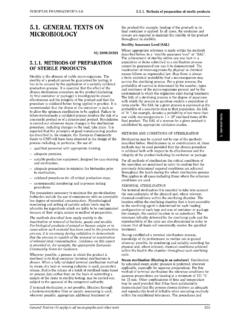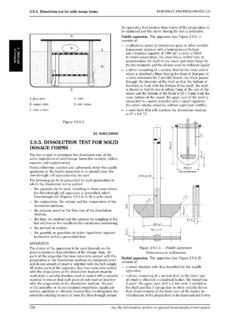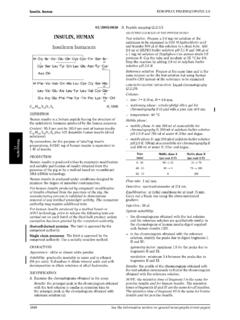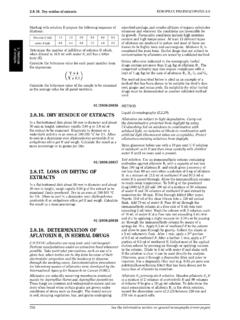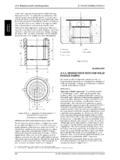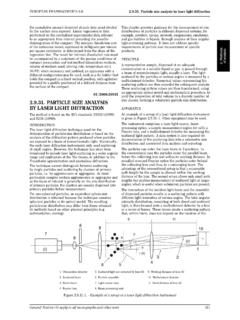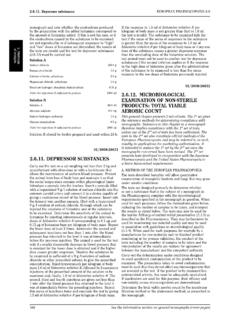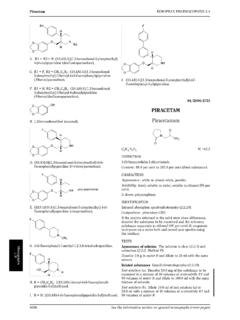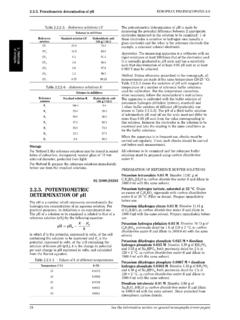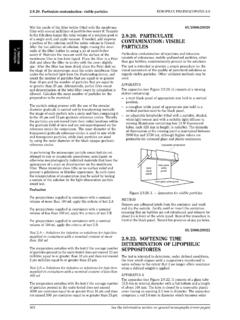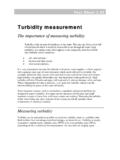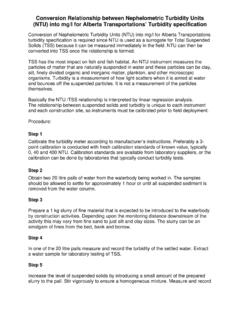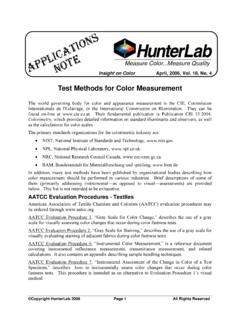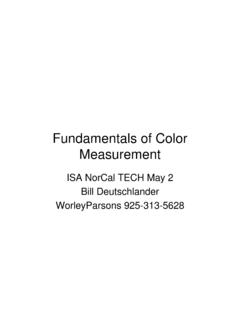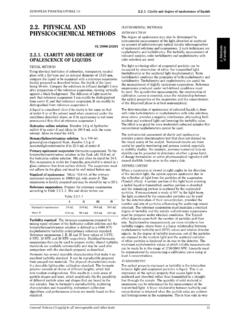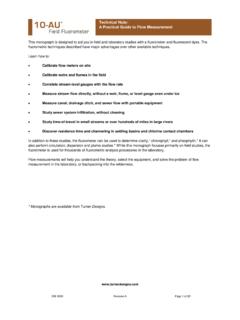Transcription of 2.2.2. DEGREE OF COLORATION OF LIQUIDS - …
1 DEGREE of COLORATION of liquidsEUROPEAN PHARMACOPOEIA lie in the range of 1750-2000 NTU. Linearity must bedemonstrated by constructing a calibration curve using atleast 4 optical property expressed as turbidity is the interactionbetween light and suspended particles in liquid . This is anexpression of the optical property that causes light to bescattered and absorbed rather than transmitted in a straightline through the sample. The quantity of solid material insuspension can be determined by the measurement of thetransmitted light. A linear relationship between turbidityand concentration is obtained when the particle sizes areuniform and homogeneous in the suspension. This is trueonly in very dilute suspensions containing small between turbidity and concentration must beestablished by constructing a calibration curve using at TURBIDIMETRYIn ratio turbidimetry the relationship of the transmissionmeasurement to the 90 scattered light measurement isdetermined.
2 This procedure compensates for the light thatis diminished by the colour of the sample. The influenceof the colour of the sample may also be eliminated byusing an infrared light-emitting diode (IR LED) at 860 sphotodiode detectors receive and measure scattered lightat a 90 angle from the sample as well as measuring theforward scatter (light reflected) in front of the sample alongwith the measurement of light transmitted directly (ratio)and are obtained by calculating the ratio of the 90 anglescattered light measured to the sum of the components offorward scattered and transmitted light values. In ratioturbidimetry the influence of stray light becomes are used for measurements of the DEGREE ofopalescence of colourless of reference suspensions I-IV with a ratioturbidimeter show a linear relationship between theconcentrations and measured NTU values. Referencesuspensions I-IV (Ph. Eur.) may be used as calibrators forthe suspensionsOpalescent values (NTU)Reference suspension I3 Reference suspension II6 Reference suspension III18 Reference suspension IV30 Standard of opalescence60 Primary opalescent suspension4000 INSTRUMENTAL DETERMINATION OF OPALESCENCER equirements in monographs are expressed in terms ofthe visual examination method with the defined referencesuspensions.
3 Instrumental methods may also be used fordetermining compliance with monograph requirements oncethe suitability of the instrument as described below has beenestablished and calibration with reference suspensions I-IVand withwater Ror the solvent used has been Ratio turbidimeters or nephelometers withselectable ratio applicationuse as light source a tungstenlamp with spectral sensitivity at about 550 nm operating ata filament colour temperature of 2700 K, or IR LED havingan emission maximum at 860 nm with a 60 nm spectralbandwidth. Other suitable light sources may also be photodiodes and photomultipliers are commonlyused as detectors and record changes in light scattered ortransmitted by the sample. The light scattered at 90 isdetected by the primary detector. Other detectors are thoseto detect back and forward scatter as well as transmitted instruments used are calibrated against standards ofknown turbidity and are capable of automatic determinationof turbidity.
4 The test results expressed in NTU units areobtained directly from the instrument and compared to thespecifications in the individual complying with the following specificationsare suitable. Measuring units: NTU. NTU is based on the turbidity ofa primary reference standard of formazin. FTU (FormazinTurbidity Units) or FNU (Formazin Nephelometry Units)are also used, and are equivalent to NTU in low regions(up to 40 NTU). These units are used in all 3 instrumentalmethods (nephelometry, turbidimetry and ratioturbidimetry). Measuring range: NTU. Resolution: NTU within the range of 0-10 NTU, NTU within the range of 10-100 NTU, and 1 NTU fortherange> with reference standards of formazin. Accuracy:0-10 NTU: (2percentofreading+ ) NTU: 5 per cent. Repeatability:0-10 NTU: NTU: 2 per cent of the measured val-ue. Calibration: with 4 reference suspensions of formazin inthe range of interest. Reference suspensions described inthis chapter or suitable reference standards calibratedagainst the primary reference suspensions may be used.
5 Stray light: this is a significant source of error in lowlevel turbidimetric measurement; stray light reaches thedetector of an optical system, but does not come from thesample; < NTU for the range 0-10 NTU, < NTUfor the range 10-1000 complying with the above characteristics andverified using the reference suspensions described underVisual method may be used instead of visual examination fordetermination of compliance with monograph with range or resolution, accuracy andrepeatability capabilities other than those mentioned abovemaybeusedprovidedtheyaresufficientl yvalidatedandare capable for the intended use. The test methodology forthe specific substance/product to be analysed must alsobe validated to demonstrate its analytical capability. Theinstrument and methodology should be consistent with theattributes of the product to be DEGREE OF COLORATION OFLIQUIDSThe examination of the DEGREE of COLORATION of LIQUIDS inthe range brown-yellow-red is carried out by one of the2 methods below, as prescribed in the it has the appearance ofwater Rorthe solvent or is not more intensely coloured than referencesolution IUsing identical tubes of colourless, transparent, neutralglass of 12 mm external diameter, compare ml of theliquid to be examined with ml ofwater Ror of thesolvent or of the reference solution (see Tables of reference22 See the information section on general monographs (cover pages)EUROPEAN PHARMACOPOEIA DEGREE of COLORATION of liquidssolutions) prescribed in the monograph.
6 Compare thecolours in diffused daylight, viewing horizontally against awhite IIUsing identical tubes of colourless, transparent, neutralglass with a flat base and an internal diameter of 15 mm to25mm,comparetheliquidtobeexaminedwithw ater Rorthe solvent or the reference solution (see Tables of referencesolutions) prescribed in the monograph, the depth of thelayer being 40 mm. Compare the colours in diffused daylight,viewing vertically against a white solutionsYellow solution. Dissolve 46 g offerric chloride Rin about900mlofamixtureof25mlofhydrochloric acid Rand975 ml ofwater Rand dilute to ml with the FeCl3,6H2O per millilitre by adding the same acidicmixture. Protect the solution from Place in a 250 ml conical flask fitted with aground-glass stopper, ml of the solution, 15 ml ofwater R,5mlofhydrochloric acid Rand 4 g ofpotassiumiodide R, close the flask, allow to stand in the dark for15 min and add 100 ml ofwater R.
7 Titrate the liberatediodine M sodium thiosulphate, solution R, added towards the end of the titration,as M sodium thiosulphateis equivalent to mgof FeCl3, chloride Rin about900mlofamixtureof25mlofhydrochloric acid Rand975 ml ofwater Rand dilute to ml with the samemixture. Titrate and adjust the solution to contain mg ofCoCl2,6H2O per millilitre by adding the same acidic Place in a 250 ml conical flask fitted with aground-glass stopper, ml of the solution, 5 ml ofdilutehydrogen peroxide solution Rand10mlofa300g/lsolution ofsodium hydroxide ,allowtocoolandadd60mlofdilute sulphuric acid Rand2gofpotassium iodide R. Close the flask and dissolvethe precipitate by shaking gently. Titrate the liberatediodine M sodium thiosulphate, solution R, added towards the end of the titration, asindicator. The end-point is reached when the solution M sodium thiosulphateis equivalent to mgof CoCl2, primary solution.
8 Dissolve 63 g ofcopper sulphate Rin about 900 ml of a mixture of 25 ml ofhydrochloric acid Rand 975 ml ofwater Rand dilute to ml with the samemixture. Titrate and adjust the solution to contain mg ofCuSO4,5H2O per millilitre by adding the same acidic Place in a 250 ml conical flask fitted with aground-glass stopper, ml of the solution, 50 ml ofwater R,12mlofdilute acetic acid Rand 3 g ofpotassiumiodide R. Titrate the liberated iodine M sodiumthiosulphate, solution R, addedtowards the end of the titration, as indicator. The end-point isreached when the solution shows a slight pale brown M sodium thiosulphateis equivalent to mgof CuSO4, solutionsUsing the 3 primary solutions, prepare the 5 standardsolutionsasfollows:Table in millilitresStandard solutionYellowsolutionRedsolutionBluesol utionHydrochloric acid(10 g/l HCl)B(brown) (brownish-yellow) (yellow) (greenish-yellow) (red) solutions for Methods I and IIUsing the 5 standard solutions, prepare the followingreference -Reference solutions BVolumes in millilitresReferencesolutionStandard solution BHydrochloric acid(10 g/l HCl) -Reference solutions BYVolumes in millilitresReferencesolutionStandard solution BY Hydrochloric acid(10 g/l HCl) -Reference solutions YVolumes in millilitresReferencesolutionStandard solution YHydrochloric acid(10 g/l HCl) (1) Potentiometric determination of pHEUROPEAN PHARMACOPOEIA -Reference solutions GYVolumes in millilitresReferencesolutionStandard solution GY Hydrochloric acid(10 g/l HCl) -Reference solutions RVolumes in millilitresReferencesolutionStandard solution R Hydrochloric acid(10 g/l HCl)
9 Method I, the reference solutions may bestored in sealedtubes of colourless, transparent, neutral glass of 12 mmexternal diameter, protected Method II, prepare the reference solutions immediatelybefore use from the standard POTENTIOMETRICDETERMINATION OF pHThe pH is a number which represents conventionally thehydrogen ion concentration of an aqueous solution. Forpractical purposes, its definition is an experimental pH of a solution to be examined is related to that of areference solution (pHs) by the following equation:in whichEis the potential, expressed in volts, of the cellcontaining the solution to be examined andEsis thepotential, expressed in volts, of the cell containing thesolution of known pH (pHs),kis the change in potentialper unit change in pH expressed in volts, and calculatedfrom the Nernst Values of k at different temperaturesTemperature ( C)k(V) potentiometric determination of pH is made bymeasuring the potential difference between 2 appropriateelectrodes immersed in the solution to be examined: 1 ofthese electrodes is sensitive to hydrogen ions (usually aglass electrode) and the other is the reference electrode (forexample, a saturated calomel electrode).
10 Apparatus. The measuring apparatus is a voltmeter with aninput resistance at least 100 times that of the electrodes is normally graduated in pH units and has a sensitivitysuch that discrimination of at least pH unit or at V may be Unless otherwise prescribed in the monograph, allmeasurements are made at the same temperature (20-25 C).Table shows the variation of pH with respect totemperature of a number of reference buffer solutionsused for calibration. For the temperature correction,when necessary, follow the manufacturer s apparatus is calibrated with the buffer solution ofpotassium hydrogen phthalate (primary standard) and1 other buffer solution of different pH (preferably oneshown in Table ). The pH of a third buffer solutionof intermediate pH read off on the scale must not differ bymore than pH unit from the value corresponding tothis solution. Immerse the electrodes in the solution to beexamined and take the reading in the same conditions asfor the buffer the apparatus is in frequent use, checks must becarried out regularly.
